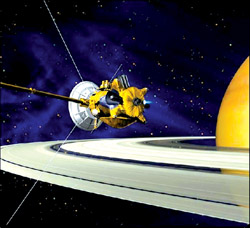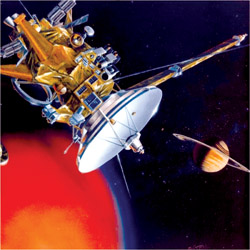Cassini - Huygens Mission
Saturn has always been among the favourite planets of most children
due to its uniqueness with the rings around it, and also since it has a
staggering count of Moons which total sixty when the objects orbiting it
a few kilometres across are also counted.
In
the list of planetary missions, the most important mission regarding
Saturn is the Cassini-Huygens Mission, which tries to explore Saturn as
well as its Moons. Therefore, itís worth looking at it since the Cassini
orbiter is still sending test results and it did the 44th flyby of
Titan, the largest moon of Saturn on March 23, 2008.
Goals of the mission
 Saturn is an exciting planet and something that brings a million
questions to oneís mind. Even though it is situated 762,760,000 miles
away from Earth and despite all the challenges, astronomers have come up
with this mission to achieve a few important goals. Saturn is an exciting planet and something that brings a million
questions to oneís mind. Even though it is situated 762,760,000 miles
away from Earth and despite all the challenges, astronomers have come up
with this mission to achieve a few important goals.
A prime goal is to determine the three-dimensional structure and
dynamic behaviour of the rings of Saturn. Since there is a large number
of Moons orbiting Saturn, astronomers have become interested to find out
whether each of them possesses any special characteristics.
Therefore, the second goal is to determine the composition of the
surface and the geological history of each Moon.
The Moon Iapetus is known to be the strangest Moon of Saturn since
one side is dark with a slight reddish colour while the other is bright.
Since there has been no valid explanation for this phenomenon,
determining the nature and origin of the dark material on Iapetusí dark
hemisphere is a goal of this mission.
Additionally, measuring the behaviour of Saturnís atmosphere at
various levels and studying in detail about Titan in terms of its
atmosphere and surface are other goals.
Important events
The journey that the Cassini made can be described as a journey which
one would dream to make in oneís lifetime. It has gone past Venus, the
Moon, a few asteroids, Jupiter and is now orbiting while observing the
many Moons of Saturn. And whatís more?
The Cassini spacecraft has taken breathtaking snapshots and sent them
to Earth all along its journey, just like we would do during a trip. In
addition to taking pictures, it also has performed many tests and
measurements on the way.
Casino
made its closest approach to Jupiter in December 2000, and took many
scientific measurements. About 26,000 images of Jupiter were taken
during the flyby which took about a month. It has produced the most
detailed picture of Jupiter yet and the smallest visible features
captured are about 60 km across.
Using images taken by Cassini, three new moons of Saturn were
discovered in 2004. They are very small and were named Methone, Pallene
and Polydeuces at the beginning of 2005.
 On May 1, 2005, another new moon was discovered by Cassini in the
Keeler Gap of the ring system, which was named Daphnis. In addition, the
orbiter has made many other important discoveries which we would carry
in the next edition since each of them is so exciting. On May 1, 2005, another new moon was discovered by Cassini in the
Keeler Gap of the ring system, which was named Daphnis. In addition, the
orbiter has made many other important discoveries which we would carry
in the next edition since each of them is so exciting.
Mission in brief
The mission is a joint project of NASA and the European Space
Association. The spacecraft launched had two parts which were the
Cassini orbiter and the Huygens probe. The orbiter was to orbit Saturn
and its Moons and study each of them, while the probe was targeted at
investigating Titan.
The Cassini orbiter is known to be the first orbiter of Saturn
although it is the fourth spacecraft to reach Saturn. Voyager 1, Voyager
2 and Pioneer 11 have reached Saturn in early points in time.
The mission was named in order to respect the Italian-French
astronomer Giovanni Domenico Cassini, and the Dutch astronomer,
mathematician and physicist, Christian Huygens. The entire project has
cost 3.26 billion dollars and seventeen countries have contributed to
make the mission a reality.
The Cassini Huygens spacecraft was launched on October 15, 1997 from
Cape Canaveral Air Force Stationís Launch Complex and it was only in
July 2004 that it entered Saturnís orbit after a long journey of nearly
seven years. The Huygensí probe separated from the orbiter in December
2004 and reached Titan in January 2005.
However, the way that the long journey was planned is extremely
interesting, and it would be obvious that such a long journey cannot be
relied on power sources for propulsion alone.
The technique that the spacecraft used is known as a gravity-assist
technique. What happens in this situation is, the spacecraft approaches
a few planets on the way and Ďstealsí a little of their orbital energy
and as a result the speed of the spacecraft is increased.
During its trip to Saturn, the Cassini spacecraft has done two
gravity-assists at Venus, one at Earth and the last at Jupiter and it
has been up to speeds of a few kilometres per second.
To be continued
Compiled by Aravinda Dassanayake |
